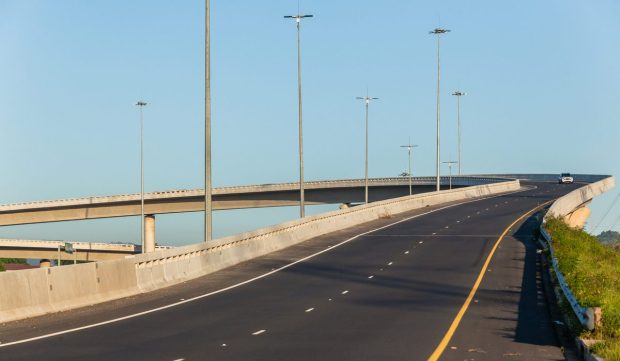The Clearing House: ACH Paves Way for Real-Time Payments On-Ramp

Checks and card transactions are giving way to electronic payments, done through an automated clearinghouse (ACH).
Jason Carone, senior vice president of ACH product management at The Clearing House (TCH), told PYMNTS’ Karen Webster that ACH’s growth is paving the way, seamlessly, for faster payments.
“It’s a natural on ramp for real time,” he said.
ACH volumes in the United States increased 8.7% in 2021, according Nacha — previously known as the National Automated Clearing House Association — and ACH transactions over TCH’s electronic payments network (EPN) grew by 9.6% over the same timeframe, outpacing the industry’s overall volume momentum. Fifty percent of the ACH commercial volume in the United States and 55% of the volume from the nation’s 50 largest financial institutions (FIs) were carried over on EPN, according to TCH.
As the stats show, 2021 proved to be a banner year for TCH’s EPN, said Carone, who added that the transformation that had been anticipated for years — namely, the shift away from paper checks — finally materialized.
“Checks may be easy,” he told Webster, “but they are inefficient.” No one — not businesses, and not individuals — really likes sending or receiving them. The pandemic forced significant changes, especially in B2B payments, he said, and it’s unlikely we’ll go back to paper-based payments, even as more of us return to working in offices (at least a couple of days a week, anyway).
Read here: ACH Volume on The Clearing House’s EPN Network Outpaced Industry in 2021
Many firms began examining their cost structures and found that writing and sending checks — especially over hundreds or even thousands of payments — was and remains a time-consuming and expensive proposition.
ACH payments are becoming truly ubiquitous. To get a sense of just how pervasive electronic payments have become, he pointed to the fact that a resounding majority of the latest advance child tax credit payments — more than 90% — were done via ACH.
And though there may not be much more runway — at least in terms of percentage point gains — each additional 1% of ACH volume represents billions of dollars of payments making the leap onto ACH.
B2B a Natural Candidate for ACH
With a drive to leave checks in the rear-view mirror, B2B seems an obvious candidate to make the (continued) leap to ACH.
Nacha, which manages the development, administration and governance of the ACH Network, said last month that 2021’s 5.3 billion B2B payments — valued at $50 trillion — reflected a 20.4% increase from 2020.
And a recent Nacha rule change that raises the value limit for same-day ACH transactions to $1 million — a tenfold increase —means that same-day ACH volumes across U.S. ACH networks will continue to rise in 2022, Carone said, noting that regular ACH limits are generally much higher.
Though there might not be that many transactions of that size moving across the network yet as same-day items, the increased limits can round out a number of use cases — allowing enterprises to take in significant sums from banks, for example, or to fund large payroll obligations on the same day.
In the healthcare sector, medical and dental practices and clinics are increasingly receiving claims payments electronically. Nacha’s data showed 426.3 million such payments made by ACH in 2021, up 17.9% from 2020.
Carone remarked that this growth is reflective of the Healthcare Electronic Funds Transfer standard, which complies with the Health Insurance Portability and Accountability Act (HIPAA) and has made it easier for healthcare providers to use the ACH network for disbursements.
P2P, Too — and the Movement to Real Time
Peer-to-peer (P2P) transactions, said Nacha, were up nearly 25%, to 271.2 million. That stat, Carone said, shows just how comfortable people are becoming with small P2P payments — your friends splitting the bill over lunch, for example, or paying your cash-only barber or cobbler.
But more recently, we’re seeing the desire for speed with those smaller-dollar payments — people want to see the money instantly.
“Payments, in general, are moving to real-time status,” he told Webster. There still will be room for same-day or next-day ACH, he said. It boils down to demand, he said — namely, how fast does a sender want to pay?
“Traditional payroll is pretty satisfied with next-day ACH,” said Carone, “but the gig economy needs to be faster,” where firms may be paying contractors (delivery drivers, for example) out several times a day — a competitive advantage for many companies.
As with any transition to electronic payments, fraud remains top-of-mind. Carone noted that fraud rates over ACH remain small — the unauthorized debit return rate was just 4 basis points. Better information flows and transparency remain key lines of defense against malicious actors, he said, though businesses are finding that business e-mail compromise attempts are on the upswing.
Social engineering fraud, he said, exists everywhere across payment networks — across card transactions, checks and, of course, electronic payments.
“The hardest part, really, is educating the consumer about the risks of those payments,” he said. “I always say: If you get a letter or e-mail saying you got a new account number, you should pick up the phone and reach out to someone you already know.”
Looking ahead, he said that we’ll see continued and organic growth across all manner of sectors (though the war in Ukraine has been a headwind) making the leap from checks and cards.
“I think that shift will take some time to get to the big retailers because they are so dependent on the cards — but there’s going to be a ground swell of smaller clients, to be begin with, that gets larger,” he said.
